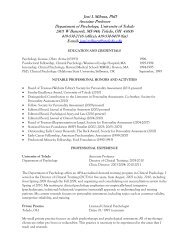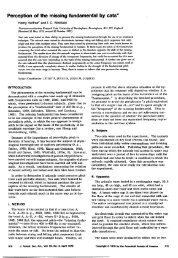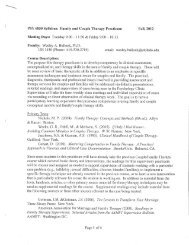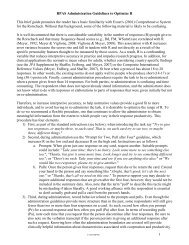The Rorschach Rating Scale: Item Adequacy, Scale ... - Psychology
The Rorschach Rating Scale: Item Adequacy, Scale ... - Psychology
The Rorschach Rating Scale: Item Adequacy, Scale ... - Psychology
- No tags were found...
Create successful ePaper yourself
Turn your PDF publications into a flip-book with our unique Google optimized e-Paper software.
206 MEYER, BATES, GACONOFactor Analytic ProceduresResearch has indicated the absolute number of participants in a factor analysis is morecritical than a specific participant-to-variable ratio (Gorsuch, 1997; Guadagnoli &Velicer, 1988) because the statistical stability of the correlation matrix is more importantthan the number of variables being intercorrelated. For instance, simulation studieshaveshownthatsamplesassmallas100canbesufficientfortheanalysisofupto72variables, whereas samples as small as 150 can be sufficient for the analysis of 144variables, provided that each analysis contains a sufficient number of high loading(i.e., > .60) variables to define each factor (Guadagnoli & Velicer, 1988). As detailedin the following text, one of our analyses (of the RRS items) contained 176 variablesand 234 participants, whereas another (of the RRS items and 5 B5M scales) contained181variablesand224participants.Althoughthenumberofvariablesinthesematricesare larger than has yet been tested in a simulation study, we analyzed the matriceskeeping in mind identifying factors would be difficult if they were defined by itemloadings less than approximately .40 (Gorsuch, 1997). More specifically, Guadagnoliand Velicer recommend retaining factors or components if they are defined by four ormore variables with loadings higher than .60, regardless of sample size, and retainingcomponents defined by 10 to 12 variables with loadings higher than .40 if the samplecontains more than 150 participants.To identify the proper number of factors to extract, we relied on a modifiedform of Horn’s parallel analysis, which is uniformly the most accurate criteria foridentifying factors in a matrix (Zwick & Velicer, 1986). Parallel analysis retainsall factors with eigenvalues larger than the average of parallel eigenvalues generatedfrom random data matrices containing the same number of “subjects” and“variables” as the target analysis. For each of our data sets, we generated 25 parallelrandom data matrices and averaged the results to identify the size of the correspondingrandomly generated eigenvalues. For instance, in our genuine data set,we had ratings on 236 participants for the 50 B5M items. To determine the propernumber of factors to extract from this data set, we generated 25 random data sets,each containing 50 “variables” and 236 “subjects.” Subsequently, for each randomdata set, we conducted a principal components analysis and recorded the magnitudeof the 50 eigenvalues (i.e., the eigenvalue for the first root, second root, thirdthe results were similar, the Beck et al. findings benefited from two features not present in our RRSdata. First, the BDI contains only 21 items. As such, the lag between an item and its counterpart on thesecond inventory in Beck et al.’s study was much shorter than the lag between repeated items on theRRS (the RRS has an average of 116 items that come between duplicate items). Second, all BDI itemsfall under the same content domain, which ensures that all raters will interpret the item consistently. Onthe RRS, all the repeated items appear in a different content area than the original. For instance, oneitem first appears in the Self-Concept section and later in the Interpersonal Beliefs, Representations,and Expectations section. Regardless of these differences, the magnitude of our item-to-item correlationsmay not be unusual.Copyright © 2000 All Rights Reserved








